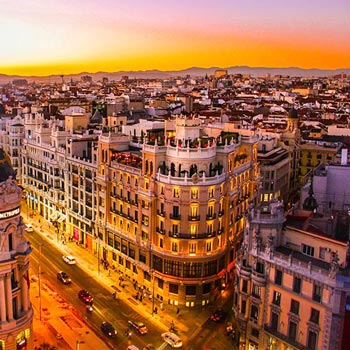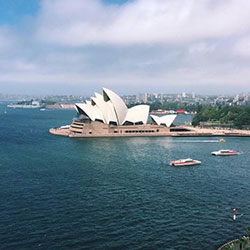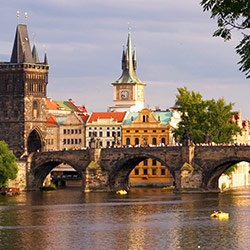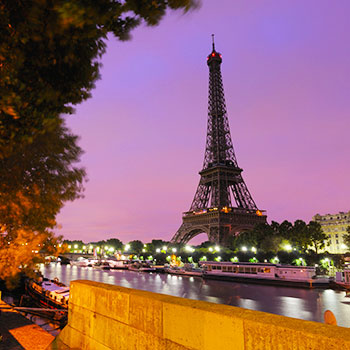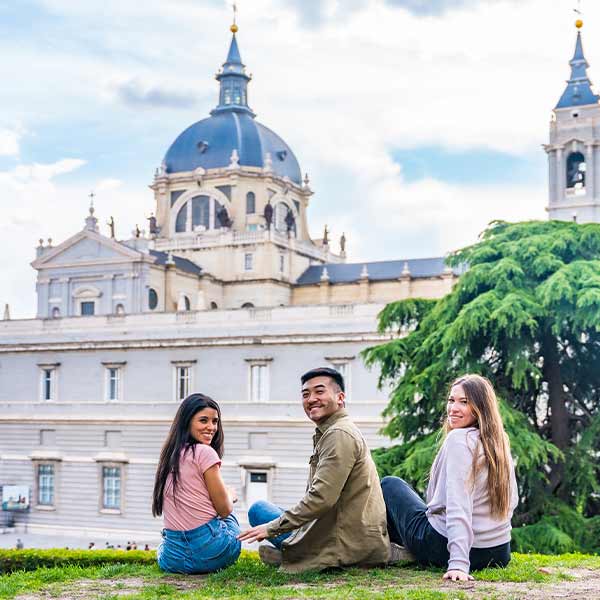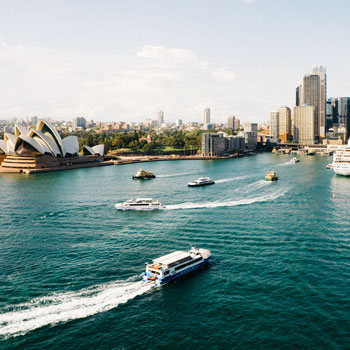Exploring Costa Rica Through Science and Culture
Academic Experiences
I love the country of Costa Rica , and that’s why I chose to study abroad here. When I signed up for this, I didn’t really think that my classes in Costa Rica would be taught in a different style than classes in the United States. I learned more about this in my orientation, but I didn’t really think about how this would impact my learning while abroad.
In the United States, my classes are typically lectures where we listen to what the professors have to say, go home and do readings, then take an exam or write a paper on the material. At my school now, our classes are more discussion and project based. It’s a lot of working with others, hearing their opinions, and creating practical solutions to environmental problems. Most days, my classes are a mix of lectures and discussions. Some days we also work on projects, do lab work, have debates, and attend online webinars. All of this helps me to learn the material better because I am able to hear how everyone perceives the things we are learning about, and doing projects helps me to understand the content better.
Along with the main differences in teaching styles, all of my classes have field trips. It’s really cool to be able to learn about things in class then experience them in real life. I’ve had two field trips so far, and they were both very interesting.
Playa Uvita, Costa Rica
My first field trip was for my Marine Mammals of Costa Rica class. We went to Playa Uvita which is also called “whale tail beach” because it looks like a whale tail at low tide. This is a beach on the Pacific Coast of Costa Rica in the Puntarenas province. My first field trip was one month after I had arrived in Costa Rica, and while that seems like a lot of time, I hadn’t really gotten to know a lot of people in my classes yet. This excursion was a great way to get to know more people in my classes and have an amazing experience with them.
Our field trip started Friday afternoon once everyone’s classes were over. We left the school on a bus at 12 and had our four-hour bus ride to Uvita. We studied for an upcoming assignment on the bus by reviewing the different types of whales and dolphins in Costa Rica and learning some facts about them. After our ride, we checked into the hotel and went to dinner. Dinner was at one of my professor’s favorite restaurants, a small Italian place, and it was a great way to get to talk to some others in my class. We returned to the hotel, and even though it was only about 7:00 pm, we were all exhausted after the long journey and went to bed very early. This was helpful because breakfast on Saturday was at 6:00 am with our activity starting at 7:00 am.
We headed to the beach and found a small boat that could hold 20 people in total. We got on the boat and started our whale watching tour! With whale watching, nothing is guaranteed, and you never know what you might see. Our guides were extremely knowledgeable and had been doing this for a long time, and in a small boat like the one that we had, there was a greater chance of seeing wildlife without scaring them away. In the area, there were reports of Atlantic spotted dolphins, false killer whales, false orca whales, and manta rays. We were able to see the Atlantic spotted dolphins during our trip, and while we were all hoping for whales and manta rays, we still were very lucky to see anything. Our assignment was to document the species that we were seeing in real life and explain how we identified them. It was amazing to be able to identify the dolphins in the wild! Our studying on the bus ride really paid off, and the boat was able to get very close to them without scaring them away.
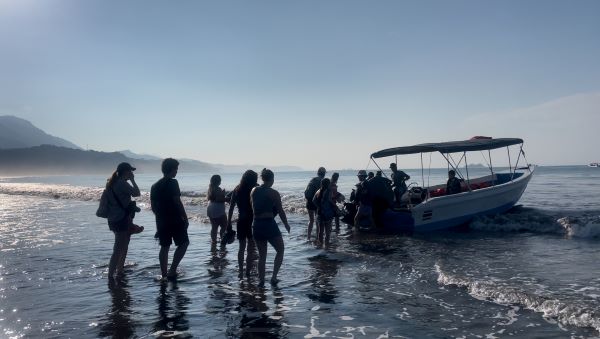
My class loading the boat in the morning of our whale watching trip. It was about 7am, and it was beautiful. We were the only ones at the beach at that time, and we got to see the sun rise a little bit when we first got there and were waiting for the boat.
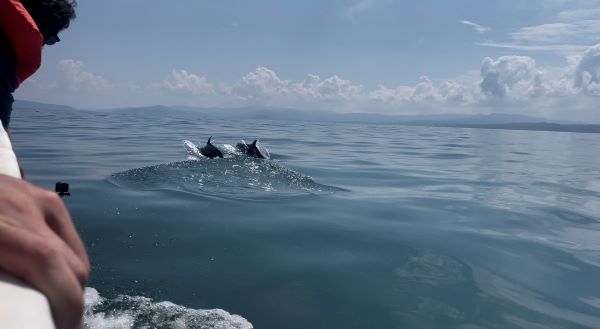
These are some of the dolphins that we saw. These are the Atlantic spotted dolphins. It’s difficult to see the spots here because of the lighting, but they were much more apparent in person. We saw about twenty dolphins total in three different pods.
After a two-hour boat ride, we went to an island and went snorkeling in the coral reefs, something that I have always dreamed of doing. While this was an amazing experience, it was also very sad and a reminder of why I am studying environmental science. About 95% of the coral reefs in that area were bleached, or had lost all pigmentation and were on their way to dying from climate change. This is something that we study in class, and seeing it in real life was very depressing. Our professor said that one year ago, they were all alive and healthy. But now, there were fish trying to find homes in dead corals that weren’t offering them food or protection. It was really difficult to see, but it reminded me that I am here learning about environmental science to prevent the extinction of coral and other essential species.
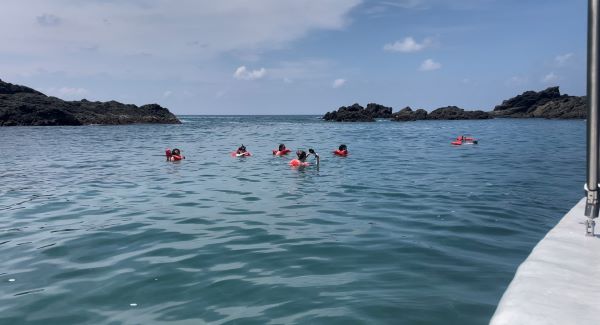
This is my class snorkeling at the island. We snorkeled for about two hours and looked at the corals, fish, sea stars, sea urchins, and whatever else we could find. While it was a very cool experience, it would have been better if we were able to see more living corals. This was a good reminder as to why I do what I do. I want to prevent the corals from going extinct.
Dota, Costa Rica
Dota is a town in the mountains of Costa Rica in the San José province, and I went there with my Freshwater Ecology class. We went to do research in the waterfalls and rivers in the mountains, and it was a lot different than all of the other places that I’ve traveled to so far. So far, I have traveled somewhere new every weekend for the last two months. But this was the first place that wasn’t touristy. It was really cool being in a natural area with lots of locals. The location was hard to get to, and we had to take a three-hour bus ride, then hike down about two miles. It was so steep that it was exhausting, but the nature and views were worth it. It was also really difficult to hike because of the altitude. Excluding planes, this was the highest elevation that I’ve ever been at with an elevation of about 8,000 feet above sea level.
When we finally got to our research location, the three groups in our class each chose a section of the river to work on. We were all working downstream of a waterfall, so the water was moving pretty fast, and it was really pretty there. The first part of our testing was collecting all of the bugs that we could find within a 45-minute time period. We wanted to see how healthy the water was by seeing what all can live in the water. After we got our bugs, we did some other general water quality tests, like testing the oxygen, pH, nitrates, and some more. This all told us how healthy the water was. After we all finished with our testing, we hiked back up the mountain and had a farm-fresh meal from the research place that we were at. It was great food, and it was nice eating fresh and healthy foods.
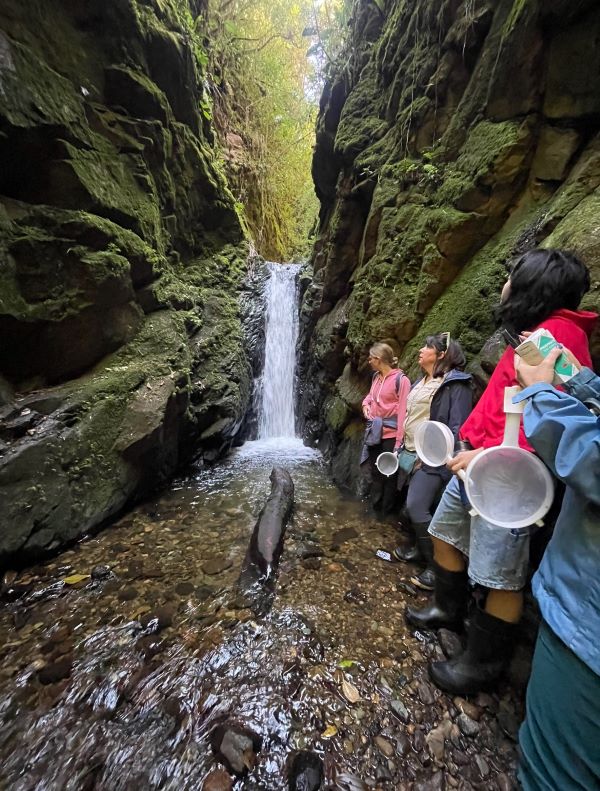
This was in Dota at the waterfall we were doing research at. It was in a location surrounded by national parks and protected areas, so it was very peaceful, serene, and natural. It was a small river and waterfall, but it still had a lot of character and unique features.
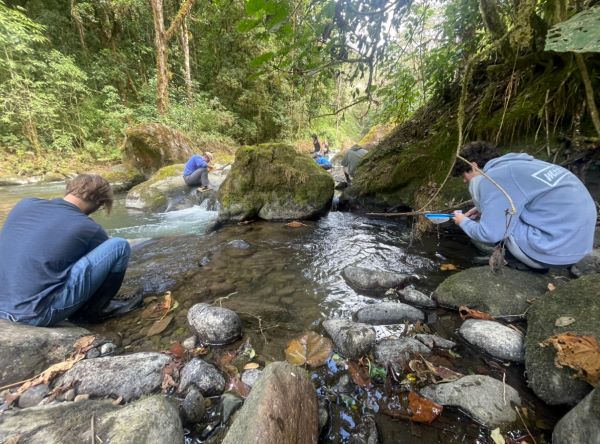
This is my group sampling the water and collecting bugs. It was very interesting, and we encountered a lot of bugs that we had never seen before.
Afterwards, we went on a hike with one of the best views I’ve ever seen. On the hike, our professor shared with us different ways to collect data and do field work even though we were not testing for these specific things. We were even able to practice how to college plankton, which involves throwing a cone-shaped net into water at a specific distance without letting it drag on the bottom of the body of water. I’m glad that we were still able to learn about things that we weren't directly practicing. After the hike, we drove for another hour and got to our hotel, had dinner, and went to sleep. The next morning, we woke up and did it again at a different location. It was interesting to compare the two different locations, because while they looked similar, they had very different water qualities that none of us expected.
So far, my field trips have been great experiences, and I’m excited for the rest of them!
